Finance in Hospitality: Analysis of Costs, Ratios, and Decisions
VerifiedAdded on 2019/12/03
|18
|5008
|356
Report
AI Summary
This report provides a comprehensive analysis of financial management within the hospitality industry. It begins by identifying various sources of funding available to a hypothetical business, including bank loans, leasing, and equity financing. The report then delves into strategies for income generation, such as hiring commission agents and leveraging sponsorships, while also examining cost elements, gross profit calculations, and pricing strategies. Furthermore, it explores methods for controlling stock and cash flow, including techniques like Just-In-Time inventory and internal audits. The report also covers the structure and purpose of trial balances and budgetary control, providing a detailed breakdown of financial statements and variance analysis. Finally, it includes a ratio analysis to assess financial performance and recommend future management strategies.
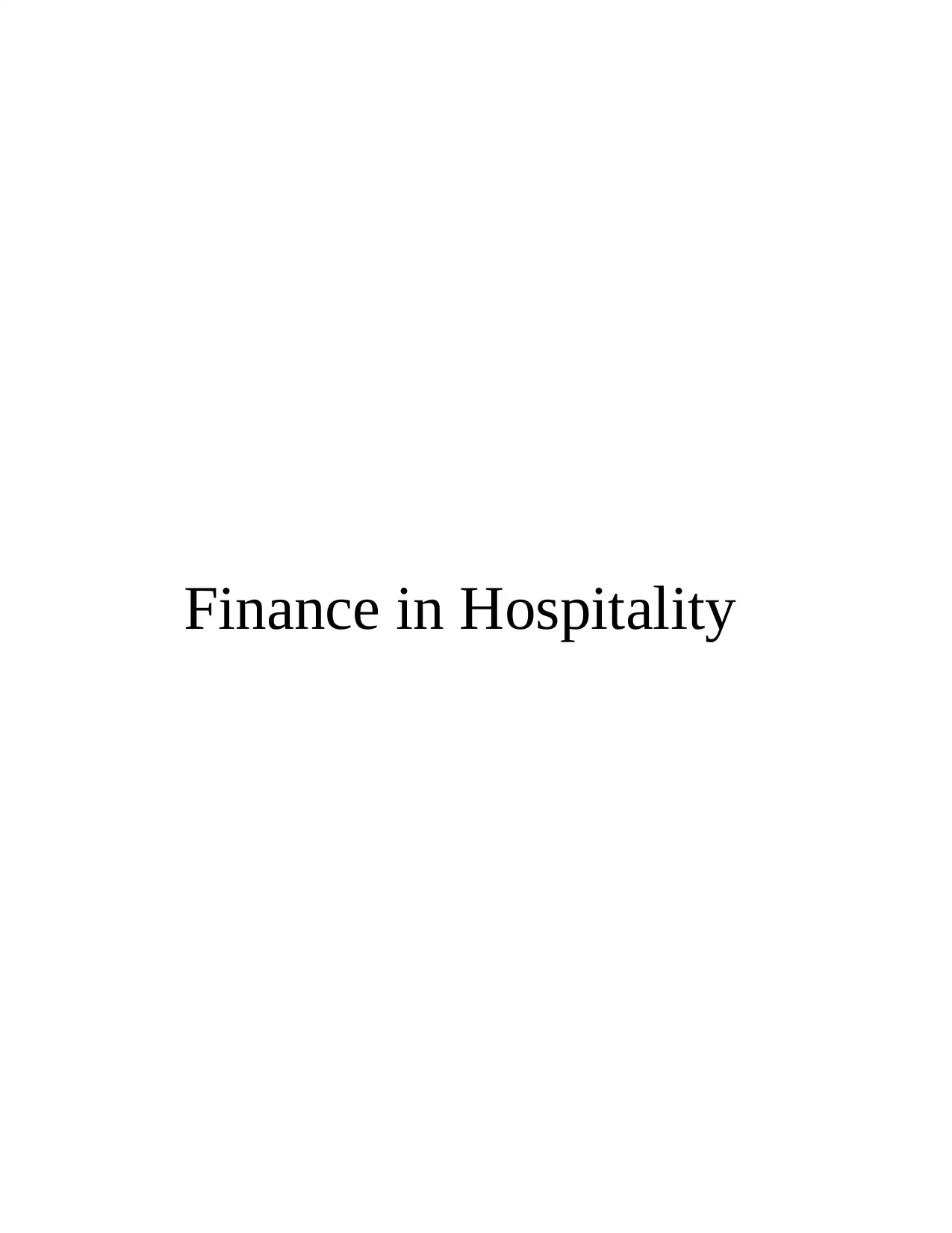
Finance in Hospitality
Paraphrase This Document
Need a fresh take? Get an instant paraphrase of this document with our AI Paraphraser
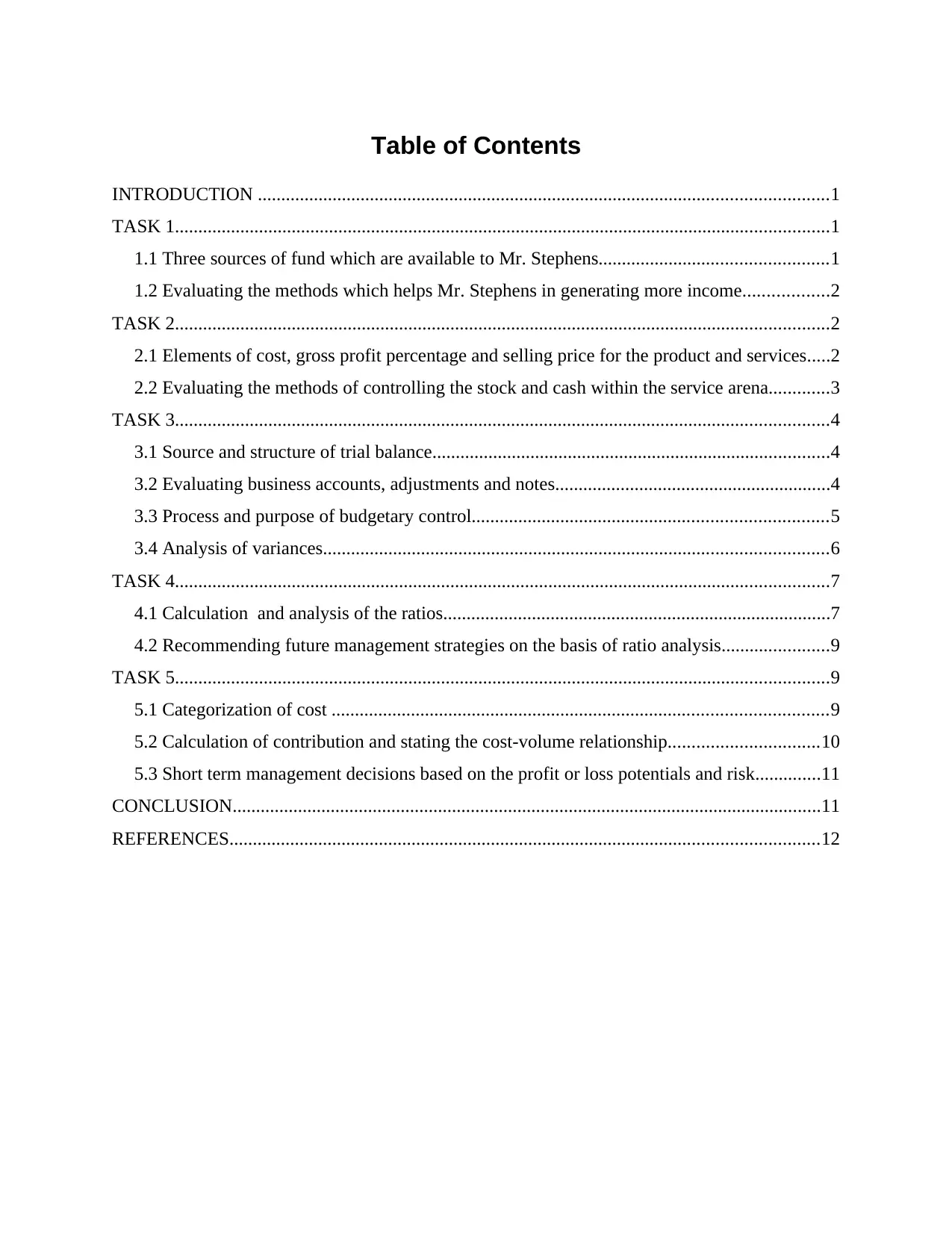
Table of Contents
INTRODUCTION ..........................................................................................................................1
TASK 1............................................................................................................................................1
1.1 Three sources of fund which are available to Mr. Stephens.................................................1
1.2 Evaluating the methods which helps Mr. Stephens in generating more income..................2
TASK 2............................................................................................................................................2
2.1 Elements of cost, gross profit percentage and selling price for the product and services.....2
2.2 Evaluating the methods of controlling the stock and cash within the service arena.............3
TASK 3............................................................................................................................................4
3.1 Source and structure of trial balance.....................................................................................4
3.2 Evaluating business accounts, adjustments and notes...........................................................4
3.3 Process and purpose of budgetary control............................................................................5
3.4 Analysis of variances............................................................................................................6
TASK 4............................................................................................................................................7
4.1 Calculation and analysis of the ratios...................................................................................7
4.2 Recommending future management strategies on the basis of ratio analysis.......................9
TASK 5............................................................................................................................................9
5.1 Categorization of cost ..........................................................................................................9
5.2 Calculation of contribution and stating the cost-volume relationship................................10
5.3 Short term management decisions based on the profit or loss potentials and risk..............11
CONCLUSION..............................................................................................................................11
REFERENCES..............................................................................................................................12
INTRODUCTION ..........................................................................................................................1
TASK 1............................................................................................................................................1
1.1 Three sources of fund which are available to Mr. Stephens.................................................1
1.2 Evaluating the methods which helps Mr. Stephens in generating more income..................2
TASK 2............................................................................................................................................2
2.1 Elements of cost, gross profit percentage and selling price for the product and services.....2
2.2 Evaluating the methods of controlling the stock and cash within the service arena.............3
TASK 3............................................................................................................................................4
3.1 Source and structure of trial balance.....................................................................................4
3.2 Evaluating business accounts, adjustments and notes...........................................................4
3.3 Process and purpose of budgetary control............................................................................5
3.4 Analysis of variances............................................................................................................6
TASK 4............................................................................................................................................7
4.1 Calculation and analysis of the ratios...................................................................................7
4.2 Recommending future management strategies on the basis of ratio analysis.......................9
TASK 5............................................................................................................................................9
5.1 Categorization of cost ..........................................................................................................9
5.2 Calculation of contribution and stating the cost-volume relationship................................10
5.3 Short term management decisions based on the profit or loss potentials and risk..............11
CONCLUSION..............................................................................................................................11
REFERENCES..............................................................................................................................12
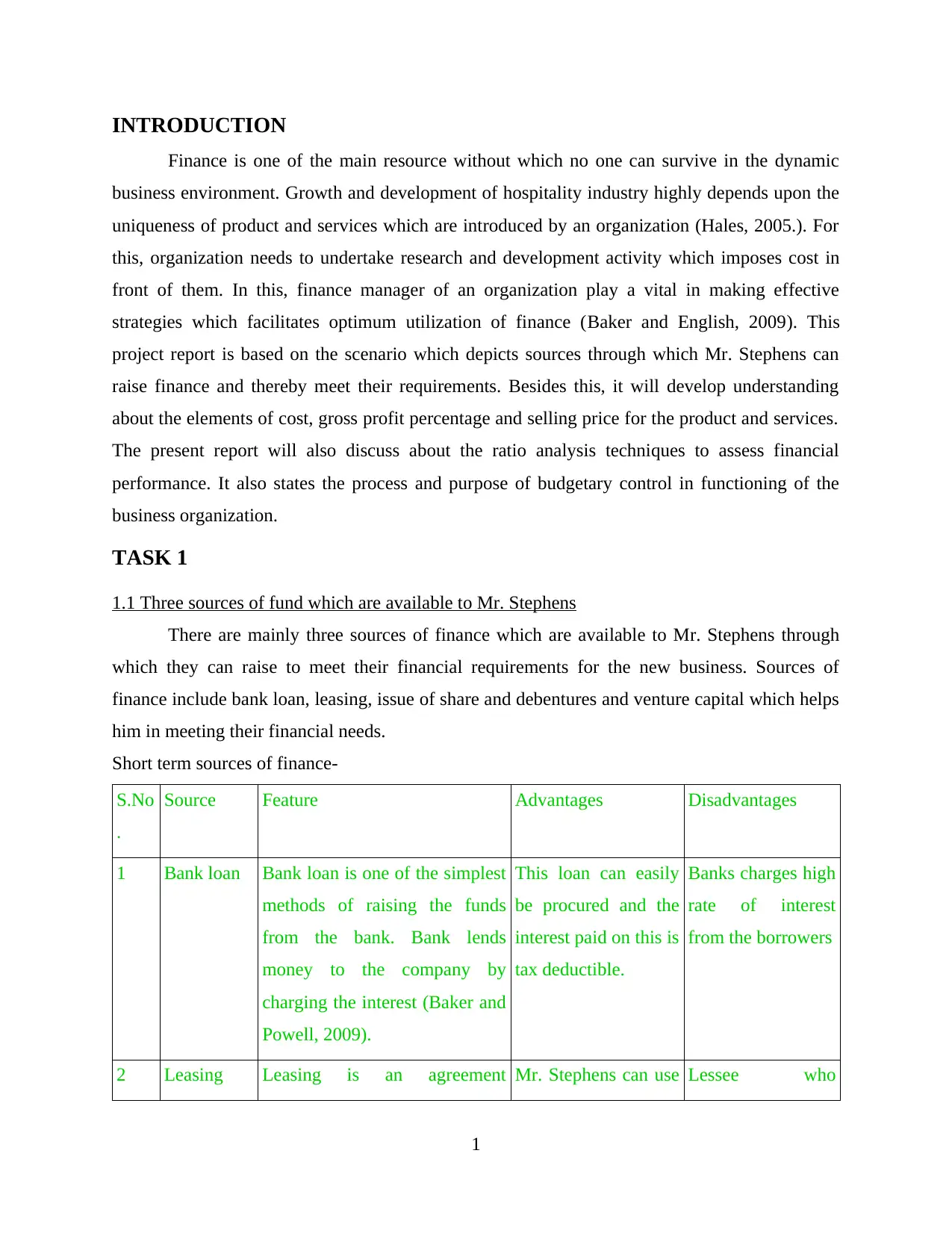
INTRODUCTION
Finance is one of the main resource without which no one can survive in the dynamic
business environment. Growth and development of hospitality industry highly depends upon the
uniqueness of product and services which are introduced by an organization (Hales, 2005.). For
this, organization needs to undertake research and development activity which imposes cost in
front of them. In this, finance manager of an organization play a vital in making effective
strategies which facilitates optimum utilization of finance (Baker and English, 2009). This
project report is based on the scenario which depicts sources through which Mr. Stephens can
raise finance and thereby meet their requirements. Besides this, it will develop understanding
about the elements of cost, gross profit percentage and selling price for the product and services.
The present report will also discuss about the ratio analysis techniques to assess financial
performance. It also states the process and purpose of budgetary control in functioning of the
business organization.
TASK 1
1.1 Three sources of fund which are available to Mr. Stephens
There are mainly three sources of finance which are available to Mr. Stephens through
which they can raise to meet their financial requirements for the new business. Sources of
finance include bank loan, leasing, issue of share and debentures and venture capital which helps
him in meeting their financial needs.
Short term sources of finance-
S.No
.
Source Feature Advantages Disadvantages
1 Bank loan Bank loan is one of the simplest
methods of raising the funds
from the bank. Bank lends
money to the company by
charging the interest (Baker and
Powell, 2009).
This loan can easily
be procured and the
interest paid on this is
tax deductible.
Banks charges high
rate of interest
from the borrowers
2 Leasing Leasing is an agreement Mr. Stephens can use Lessee who
1
Finance is one of the main resource without which no one can survive in the dynamic
business environment. Growth and development of hospitality industry highly depends upon the
uniqueness of product and services which are introduced by an organization (Hales, 2005.). For
this, organization needs to undertake research and development activity which imposes cost in
front of them. In this, finance manager of an organization play a vital in making effective
strategies which facilitates optimum utilization of finance (Baker and English, 2009). This
project report is based on the scenario which depicts sources through which Mr. Stephens can
raise finance and thereby meet their requirements. Besides this, it will develop understanding
about the elements of cost, gross profit percentage and selling price for the product and services.
The present report will also discuss about the ratio analysis techniques to assess financial
performance. It also states the process and purpose of budgetary control in functioning of the
business organization.
TASK 1
1.1 Three sources of fund which are available to Mr. Stephens
There are mainly three sources of finance which are available to Mr. Stephens through
which they can raise to meet their financial requirements for the new business. Sources of
finance include bank loan, leasing, issue of share and debentures and venture capital which helps
him in meeting their financial needs.
Short term sources of finance-
S.No
.
Source Feature Advantages Disadvantages
1 Bank loan Bank loan is one of the simplest
methods of raising the funds
from the bank. Bank lends
money to the company by
charging the interest (Baker and
Powell, 2009).
This loan can easily
be procured and the
interest paid on this is
tax deductible.
Banks charges high
rate of interest
from the borrowers
2 Leasing Leasing is an agreement Mr. Stephens can use Lessee who
1
⊘ This is a preview!⊘
Do you want full access?
Subscribe today to unlock all pages.

Trusted by 1+ million students worldwide
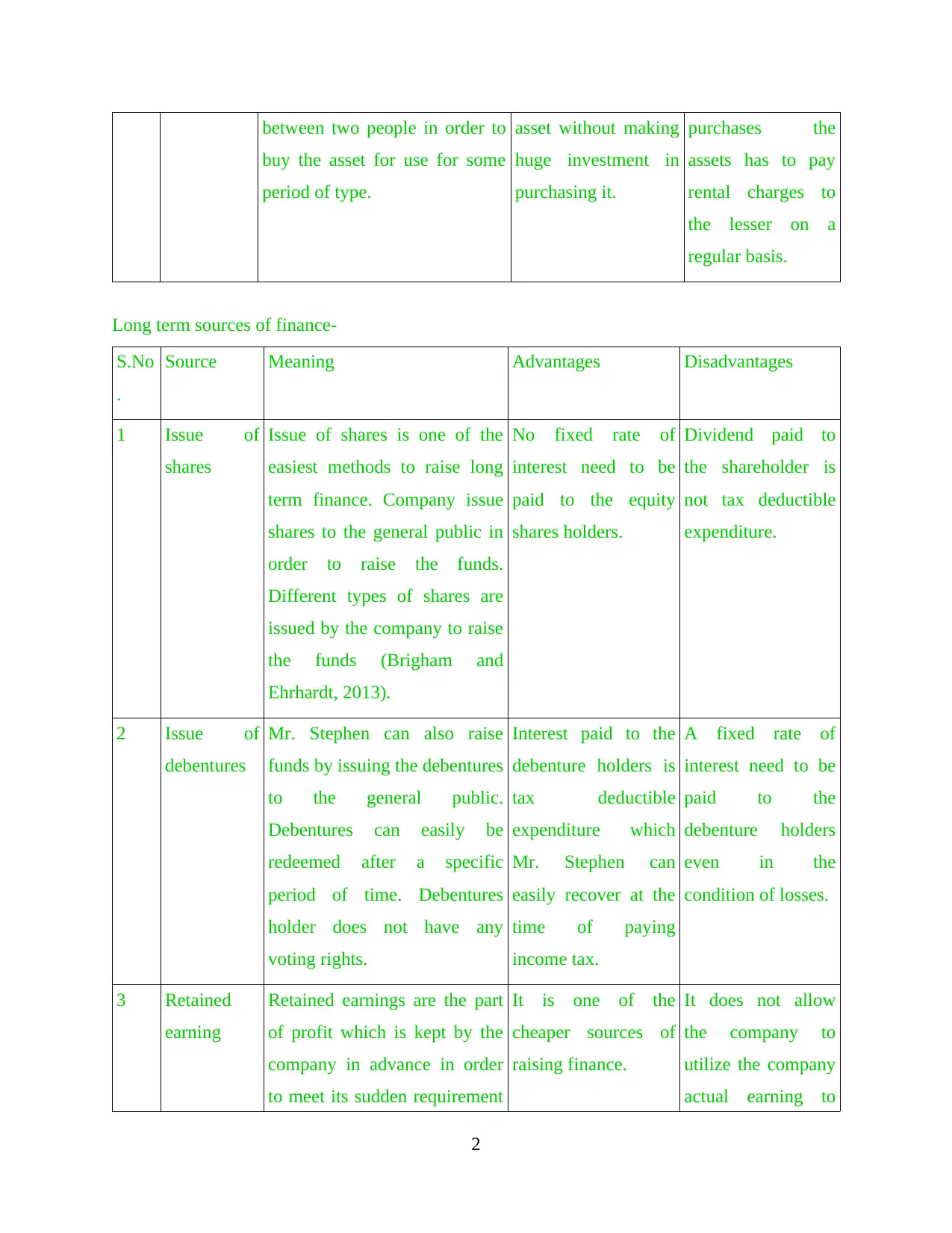
between two people in order to
buy the asset for use for some
period of type.
asset without making
huge investment in
purchasing it.
purchases the
assets has to pay
rental charges to
the lesser on a
regular basis.
Long term sources of finance-
S.No
.
Source Meaning Advantages Disadvantages
1 Issue of
shares
Issue of shares is one of the
easiest methods to raise long
term finance. Company issue
shares to the general public in
order to raise the funds.
Different types of shares are
issued by the company to raise
the funds (Brigham and
Ehrhardt, 2013).
No fixed rate of
interest need to be
paid to the equity
shares holders.
Dividend paid to
the shareholder is
not tax deductible
expenditure.
2 Issue of
debentures
Mr. Stephen can also raise
funds by issuing the debentures
to the general public.
Debentures can easily be
redeemed after a specific
period of time. Debentures
holder does not have any
voting rights.
Interest paid to the
debenture holders is
tax deductible
expenditure which
Mr. Stephen can
easily recover at the
time of paying
income tax.
A fixed rate of
interest need to be
paid to the
debenture holders
even in the
condition of losses.
3 Retained
earning
Retained earnings are the part
of profit which is kept by the
company in advance in order
to meet its sudden requirement
It is one of the
cheaper sources of
raising finance.
It does not allow
the company to
utilize the company
actual earning to
2
buy the asset for use for some
period of type.
asset without making
huge investment in
purchasing it.
purchases the
assets has to pay
rental charges to
the lesser on a
regular basis.
Long term sources of finance-
S.No
.
Source Meaning Advantages Disadvantages
1 Issue of
shares
Issue of shares is one of the
easiest methods to raise long
term finance. Company issue
shares to the general public in
order to raise the funds.
Different types of shares are
issued by the company to raise
the funds (Brigham and
Ehrhardt, 2013).
No fixed rate of
interest need to be
paid to the equity
shares holders.
Dividend paid to
the shareholder is
not tax deductible
expenditure.
2 Issue of
debentures
Mr. Stephen can also raise
funds by issuing the debentures
to the general public.
Debentures can easily be
redeemed after a specific
period of time. Debentures
holder does not have any
voting rights.
Interest paid to the
debenture holders is
tax deductible
expenditure which
Mr. Stephen can
easily recover at the
time of paying
income tax.
A fixed rate of
interest need to be
paid to the
debenture holders
even in the
condition of losses.
3 Retained
earning
Retained earnings are the part
of profit which is kept by the
company in advance in order
to meet its sudden requirement
It is one of the
cheaper sources of
raising finance.
It does not allow
the company to
utilize the company
actual earning to
2
Paraphrase This Document
Need a fresh take? Get an instant paraphrase of this document with our AI Paraphraser
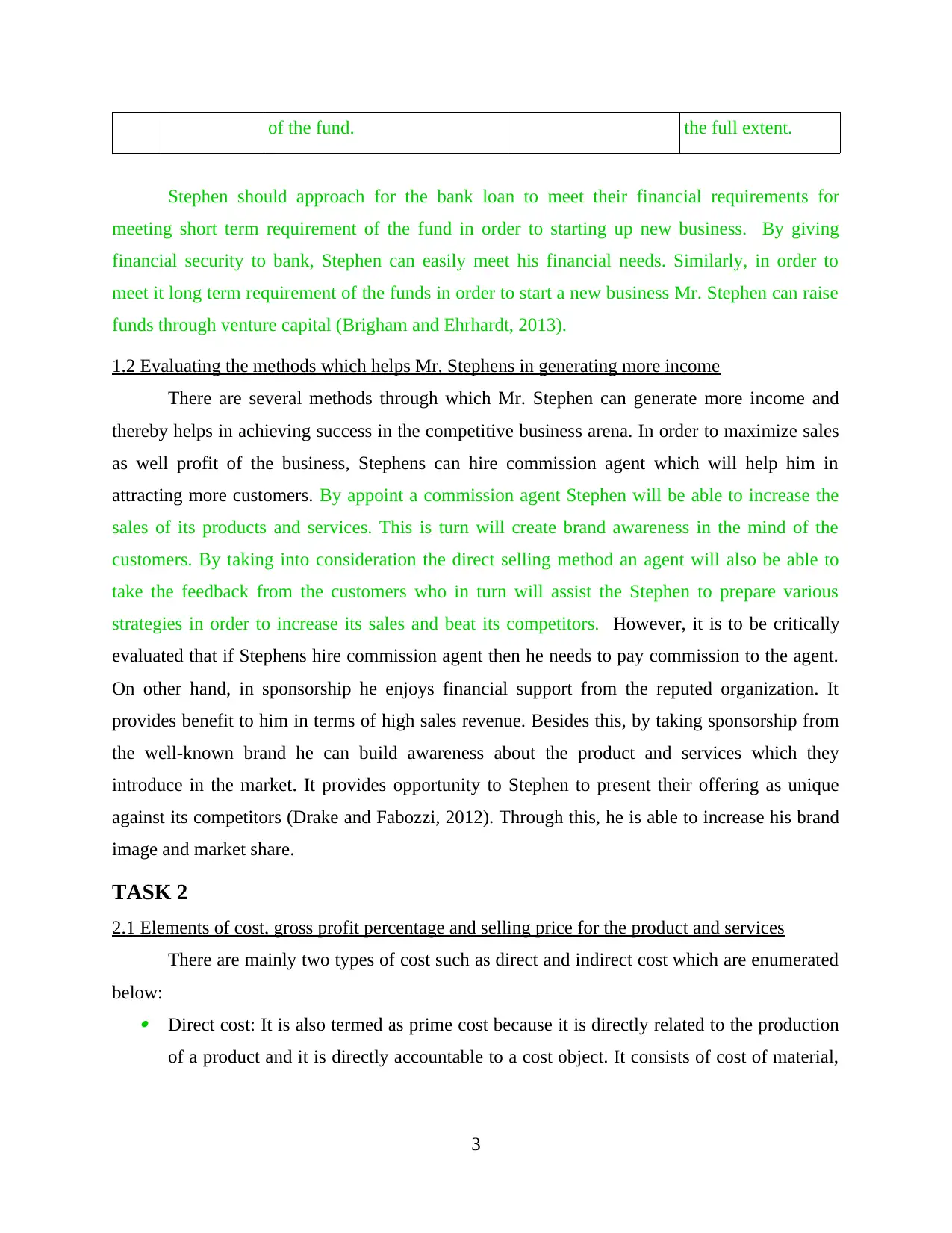
of the fund. the full extent.
Stephen should approach for the bank loan to meet their financial requirements for
meeting short term requirement of the fund in order to starting up new business. By giving
financial security to bank, Stephen can easily meet his financial needs. Similarly, in order to
meet it long term requirement of the funds in order to start a new business Mr. Stephen can raise
funds through venture capital (Brigham and Ehrhardt, 2013).
1.2 Evaluating the methods which helps Mr. Stephens in generating more income
There are several methods through which Mr. Stephen can generate more income and
thereby helps in achieving success in the competitive business arena. In order to maximize sales
as well profit of the business, Stephens can hire commission agent which will help him in
attracting more customers. By appoint a commission agent Stephen will be able to increase the
sales of its products and services. This is turn will create brand awareness in the mind of the
customers. By taking into consideration the direct selling method an agent will also be able to
take the feedback from the customers who in turn will assist the Stephen to prepare various
strategies in order to increase its sales and beat its competitors. However, it is to be critically
evaluated that if Stephens hire commission agent then he needs to pay commission to the agent.
On other hand, in sponsorship he enjoys financial support from the reputed organization. It
provides benefit to him in terms of high sales revenue. Besides this, by taking sponsorship from
the well-known brand he can build awareness about the product and services which they
introduce in the market. It provides opportunity to Stephen to present their offering as unique
against its competitors (Drake and Fabozzi, 2012). Through this, he is able to increase his brand
image and market share.
TASK 2
2.1 Elements of cost, gross profit percentage and selling price for the product and services
There are mainly two types of cost such as direct and indirect cost which are enumerated
below: Direct cost: It is also termed as prime cost because it is directly related to the production
of a product and it is directly accountable to a cost object. It consists of cost of material,
3
Stephen should approach for the bank loan to meet their financial requirements for
meeting short term requirement of the fund in order to starting up new business. By giving
financial security to bank, Stephen can easily meet his financial needs. Similarly, in order to
meet it long term requirement of the funds in order to start a new business Mr. Stephen can raise
funds through venture capital (Brigham and Ehrhardt, 2013).
1.2 Evaluating the methods which helps Mr. Stephens in generating more income
There are several methods through which Mr. Stephen can generate more income and
thereby helps in achieving success in the competitive business arena. In order to maximize sales
as well profit of the business, Stephens can hire commission agent which will help him in
attracting more customers. By appoint a commission agent Stephen will be able to increase the
sales of its products and services. This is turn will create brand awareness in the mind of the
customers. By taking into consideration the direct selling method an agent will also be able to
take the feedback from the customers who in turn will assist the Stephen to prepare various
strategies in order to increase its sales and beat its competitors. However, it is to be critically
evaluated that if Stephens hire commission agent then he needs to pay commission to the agent.
On other hand, in sponsorship he enjoys financial support from the reputed organization. It
provides benefit to him in terms of high sales revenue. Besides this, by taking sponsorship from
the well-known brand he can build awareness about the product and services which they
introduce in the market. It provides opportunity to Stephen to present their offering as unique
against its competitors (Drake and Fabozzi, 2012). Through this, he is able to increase his brand
image and market share.
TASK 2
2.1 Elements of cost, gross profit percentage and selling price for the product and services
There are mainly two types of cost such as direct and indirect cost which are enumerated
below: Direct cost: It is also termed as prime cost because it is directly related to the production
of a product and it is directly accountable to a cost object. It consists of cost of material,
3
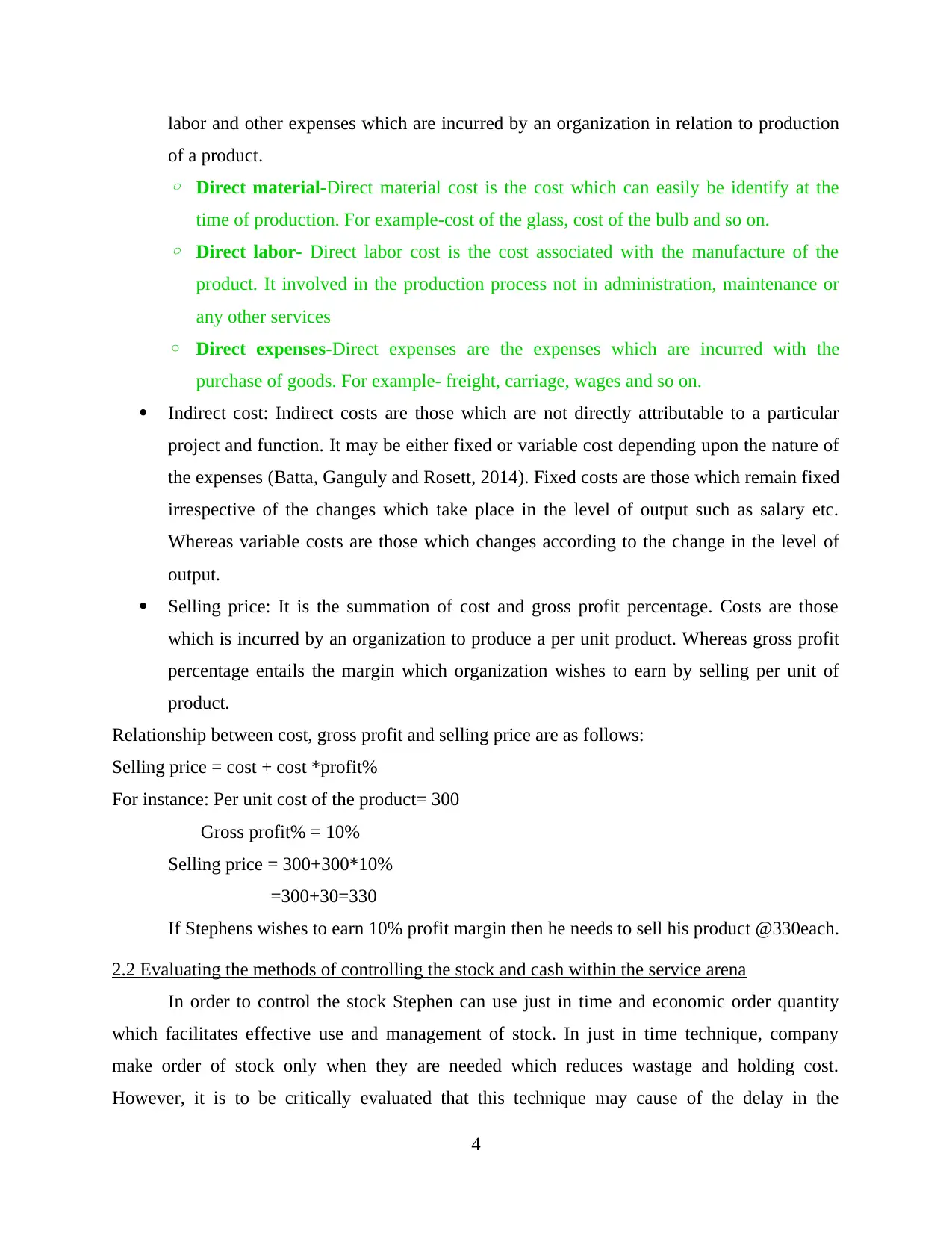
labor and other expenses which are incurred by an organization in relation to production
of a product.
◦ Direct material-Direct material cost is the cost which can easily be identify at the
time of production. For example-cost of the glass, cost of the bulb and so on.
◦ Direct labor- Direct labor cost is the cost associated with the manufacture of the
product. It involved in the production process not in administration, maintenance or
any other services
◦ Direct expenses-Direct expenses are the expenses which are incurred with the
purchase of goods. For example- freight, carriage, wages and so on.
Indirect cost: Indirect costs are those which are not directly attributable to a particular
project and function. It may be either fixed or variable cost depending upon the nature of
the expenses (Batta, Ganguly and Rosett, 2014). Fixed costs are those which remain fixed
irrespective of the changes which take place in the level of output such as salary etc.
Whereas variable costs are those which changes according to the change in the level of
output.
Selling price: It is the summation of cost and gross profit percentage. Costs are those
which is incurred by an organization to produce a per unit product. Whereas gross profit
percentage entails the margin which organization wishes to earn by selling per unit of
product.
Relationship between cost, gross profit and selling price are as follows:
Selling price = cost + cost *profit%
For instance: Per unit cost of the product= 300
Gross profit% = 10%
Selling price = 300+300*10%
=300+30=330
If Stephens wishes to earn 10% profit margin then he needs to sell his product @330each.
2.2 Evaluating the methods of controlling the stock and cash within the service arena
In order to control the stock Stephen can use just in time and economic order quantity
which facilitates effective use and management of stock. In just in time technique, company
make order of stock only when they are needed which reduces wastage and holding cost.
However, it is to be critically evaluated that this technique may cause of the delay in the
4
of a product.
◦ Direct material-Direct material cost is the cost which can easily be identify at the
time of production. For example-cost of the glass, cost of the bulb and so on.
◦ Direct labor- Direct labor cost is the cost associated with the manufacture of the
product. It involved in the production process not in administration, maintenance or
any other services
◦ Direct expenses-Direct expenses are the expenses which are incurred with the
purchase of goods. For example- freight, carriage, wages and so on.
Indirect cost: Indirect costs are those which are not directly attributable to a particular
project and function. It may be either fixed or variable cost depending upon the nature of
the expenses (Batta, Ganguly and Rosett, 2014). Fixed costs are those which remain fixed
irrespective of the changes which take place in the level of output such as salary etc.
Whereas variable costs are those which changes according to the change in the level of
output.
Selling price: It is the summation of cost and gross profit percentage. Costs are those
which is incurred by an organization to produce a per unit product. Whereas gross profit
percentage entails the margin which organization wishes to earn by selling per unit of
product.
Relationship between cost, gross profit and selling price are as follows:
Selling price = cost + cost *profit%
For instance: Per unit cost of the product= 300
Gross profit% = 10%
Selling price = 300+300*10%
=300+30=330
If Stephens wishes to earn 10% profit margin then he needs to sell his product @330each.
2.2 Evaluating the methods of controlling the stock and cash within the service arena
In order to control the stock Stephen can use just in time and economic order quantity
which facilitates effective use and management of stock. In just in time technique, company
make order of stock only when they are needed which reduces wastage and holding cost.
However, it is to be critically evaluated that this technique may cause of the delay in the
4
⊘ This is a preview!⊘
Do you want full access?
Subscribe today to unlock all pages.

Trusted by 1+ million students worldwide
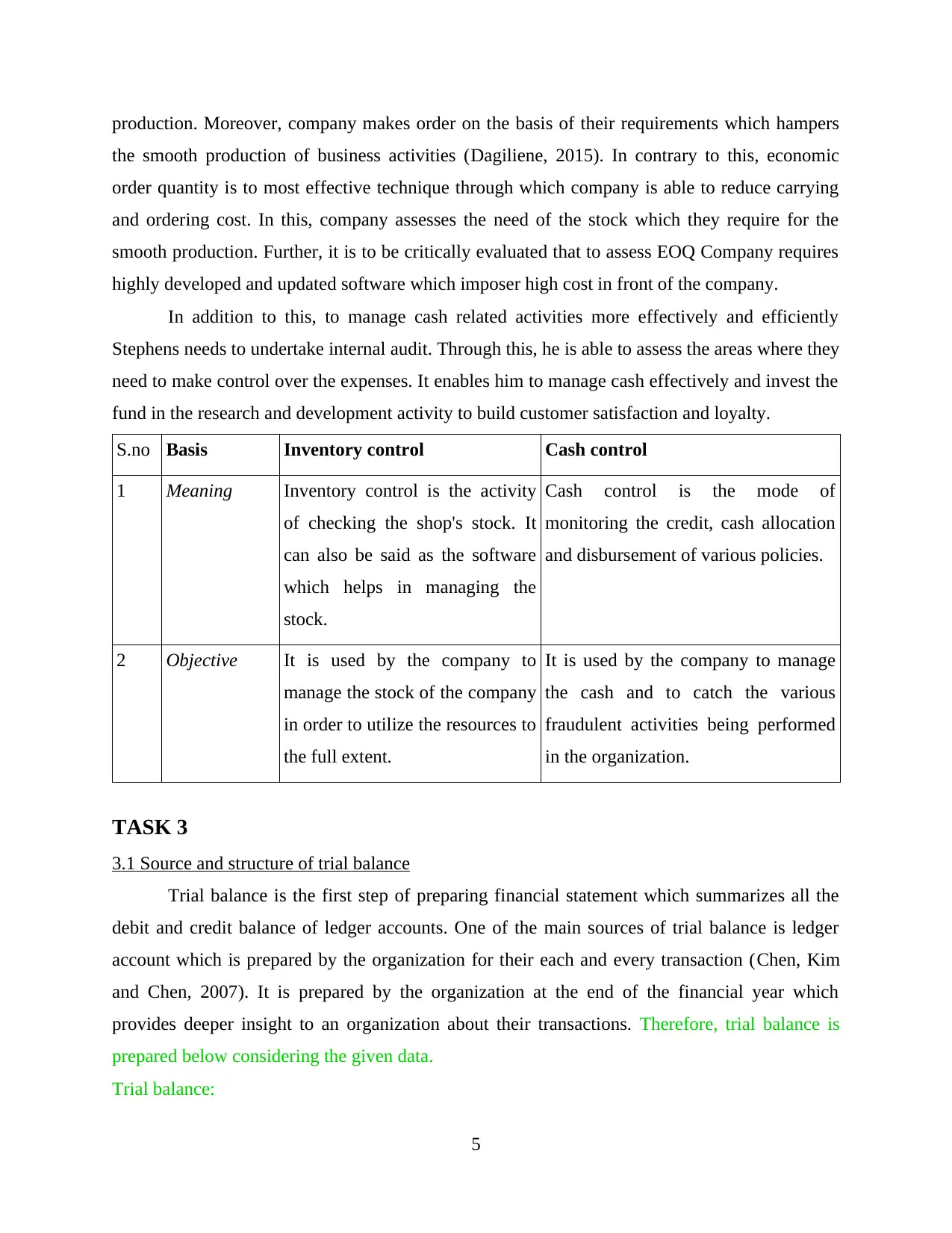
production. Moreover, company makes order on the basis of their requirements which hampers
the smooth production of business activities (Dagiliene, 2015). In contrary to this, economic
order quantity is to most effective technique through which company is able to reduce carrying
and ordering cost. In this, company assesses the need of the stock which they require for the
smooth production. Further, it is to be critically evaluated that to assess EOQ Company requires
highly developed and updated software which imposer high cost in front of the company.
In addition to this, to manage cash related activities more effectively and efficiently
Stephens needs to undertake internal audit. Through this, he is able to assess the areas where they
need to make control over the expenses. It enables him to manage cash effectively and invest the
fund in the research and development activity to build customer satisfaction and loyalty.
S.no Basis Inventory control Cash control
1 Meaning Inventory control is the activity
of checking the shop's stock. It
can also be said as the software
which helps in managing the
stock.
Cash control is the mode of
monitoring the credit, cash allocation
and disbursement of various policies.
2 Objective It is used by the company to
manage the stock of the company
in order to utilize the resources to
the full extent.
It is used by the company to manage
the cash and to catch the various
fraudulent activities being performed
in the organization.
TASK 3
3.1 Source and structure of trial balance
Trial balance is the first step of preparing financial statement which summarizes all the
debit and credit balance of ledger accounts. One of the main sources of trial balance is ledger
account which is prepared by the organization for their each and every transaction (Chen, Kim
and Chen, 2007). It is prepared by the organization at the end of the financial year which
provides deeper insight to an organization about their transactions. Therefore, trial balance is
prepared below considering the given data.
Trial balance:
5
the smooth production of business activities (Dagiliene, 2015). In contrary to this, economic
order quantity is to most effective technique through which company is able to reduce carrying
and ordering cost. In this, company assesses the need of the stock which they require for the
smooth production. Further, it is to be critically evaluated that to assess EOQ Company requires
highly developed and updated software which imposer high cost in front of the company.
In addition to this, to manage cash related activities more effectively and efficiently
Stephens needs to undertake internal audit. Through this, he is able to assess the areas where they
need to make control over the expenses. It enables him to manage cash effectively and invest the
fund in the research and development activity to build customer satisfaction and loyalty.
S.no Basis Inventory control Cash control
1 Meaning Inventory control is the activity
of checking the shop's stock. It
can also be said as the software
which helps in managing the
stock.
Cash control is the mode of
monitoring the credit, cash allocation
and disbursement of various policies.
2 Objective It is used by the company to
manage the stock of the company
in order to utilize the resources to
the full extent.
It is used by the company to manage
the cash and to catch the various
fraudulent activities being performed
in the organization.
TASK 3
3.1 Source and structure of trial balance
Trial balance is the first step of preparing financial statement which summarizes all the
debit and credit balance of ledger accounts. One of the main sources of trial balance is ledger
account which is prepared by the organization for their each and every transaction (Chen, Kim
and Chen, 2007). It is prepared by the organization at the end of the financial year which
provides deeper insight to an organization about their transactions. Therefore, trial balance is
prepared below considering the given data.
Trial balance:
5
Paraphrase This Document
Need a fresh take? Get an instant paraphrase of this document with our AI Paraphraser
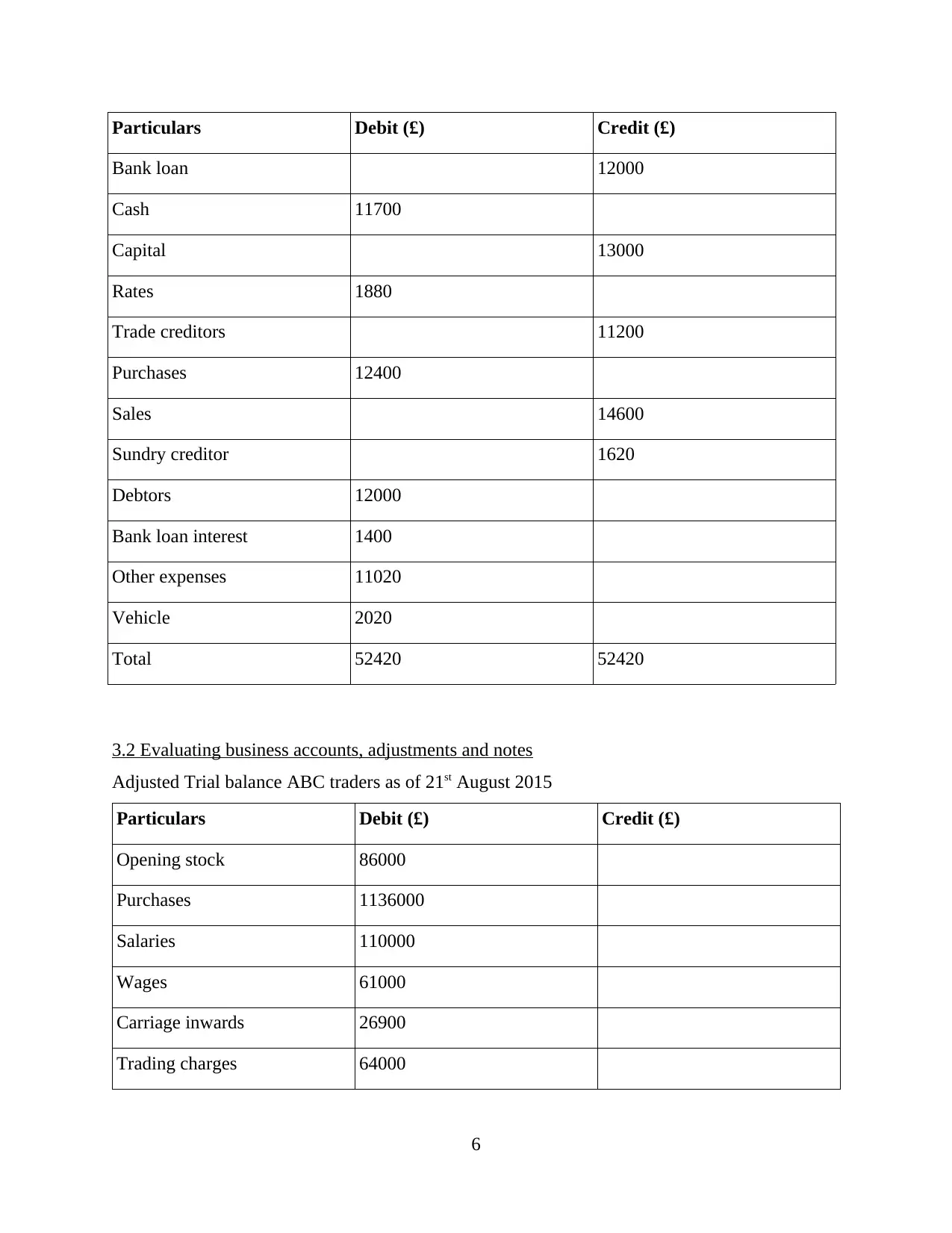
Particulars Debit (£) Credit (£)
Bank loan 12000
Cash 11700
Capital 13000
Rates 1880
Trade creditors 11200
Purchases 12400
Sales 14600
Sundry creditor 1620
Debtors 12000
Bank loan interest 1400
Other expenses 11020
Vehicle 2020
Total 52420 52420
3.2 Evaluating business accounts, adjustments and notes
Adjusted Trial balance ABC traders as of 21st August 2015
Particulars Debit (£) Credit (£)
Opening stock 86000
Purchases 1136000
Salaries 110000
Wages 61000
Carriage inwards 26900
Trading charges 64000
6
Bank loan 12000
Cash 11700
Capital 13000
Rates 1880
Trade creditors 11200
Purchases 12400
Sales 14600
Sundry creditor 1620
Debtors 12000
Bank loan interest 1400
Other expenses 11020
Vehicle 2020
Total 52420 52420
3.2 Evaluating business accounts, adjustments and notes
Adjusted Trial balance ABC traders as of 21st August 2015
Particulars Debit (£) Credit (£)
Opening stock 86000
Purchases 1136000
Salaries 110000
Wages 61000
Carriage inwards 26900
Trading charges 64000
6
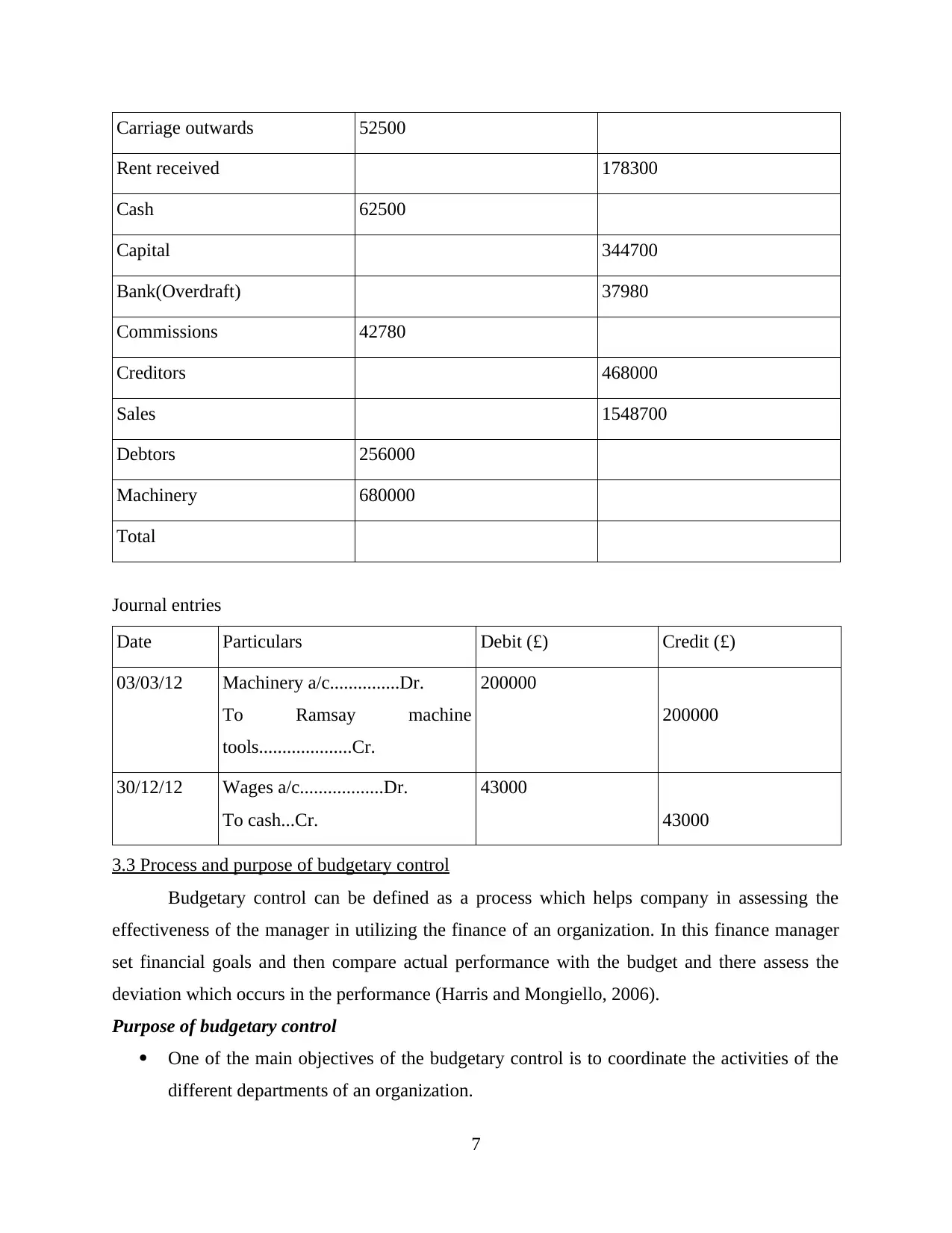
Carriage outwards 52500
Rent received 178300
Cash 62500
Capital 344700
Bank(Overdraft) 37980
Commissions 42780
Creditors 468000
Sales 1548700
Debtors 256000
Machinery 680000
Total
Journal entries
Date Particulars Debit (£) Credit (£)
03/03/12 Machinery a/c...............Dr.
To Ramsay machine
tools....................Cr.
200000
200000
30/12/12 Wages a/c..................Dr.
To cash...Cr.
43000
43000
3.3 Process and purpose of budgetary control
Budgetary control can be defined as a process which helps company in assessing the
effectiveness of the manager in utilizing the finance of an organization. In this finance manager
set financial goals and then compare actual performance with the budget and there assess the
deviation which occurs in the performance (Harris and Mongiello, 2006).
Purpose of budgetary control
One of the main objectives of the budgetary control is to coordinate the activities of the
different departments of an organization.
7
Rent received 178300
Cash 62500
Capital 344700
Bank(Overdraft) 37980
Commissions 42780
Creditors 468000
Sales 1548700
Debtors 256000
Machinery 680000
Total
Journal entries
Date Particulars Debit (£) Credit (£)
03/03/12 Machinery a/c...............Dr.
To Ramsay machine
tools....................Cr.
200000
200000
30/12/12 Wages a/c..................Dr.
To cash...Cr.
43000
43000
3.3 Process and purpose of budgetary control
Budgetary control can be defined as a process which helps company in assessing the
effectiveness of the manager in utilizing the finance of an organization. In this finance manager
set financial goals and then compare actual performance with the budget and there assess the
deviation which occurs in the performance (Harris and Mongiello, 2006).
Purpose of budgetary control
One of the main objectives of the budgetary control is to coordinate the activities of the
different departments of an organization.
7
⊘ This is a preview!⊘
Do you want full access?
Subscribe today to unlock all pages.

Trusted by 1+ million students worldwide
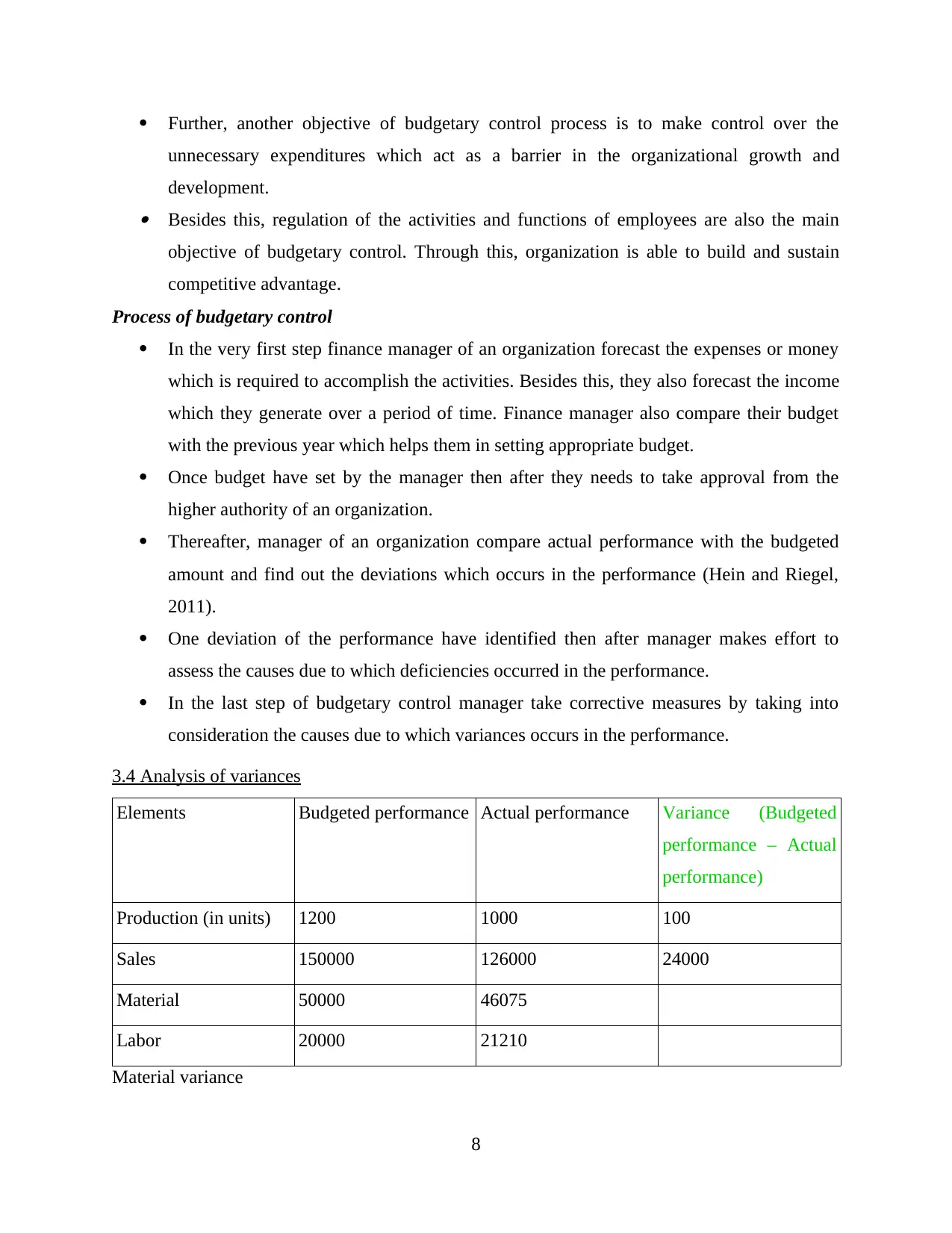
Further, another objective of budgetary control process is to make control over the
unnecessary expenditures which act as a barrier in the organizational growth and
development. Besides this, regulation of the activities and functions of employees are also the main
objective of budgetary control. Through this, organization is able to build and sustain
competitive advantage.
Process of budgetary control
In the very first step finance manager of an organization forecast the expenses or money
which is required to accomplish the activities. Besides this, they also forecast the income
which they generate over a period of time. Finance manager also compare their budget
with the previous year which helps them in setting appropriate budget.
Once budget have set by the manager then after they needs to take approval from the
higher authority of an organization.
Thereafter, manager of an organization compare actual performance with the budgeted
amount and find out the deviations which occurs in the performance (Hein and Riegel,
2011).
One deviation of the performance have identified then after manager makes effort to
assess the causes due to which deficiencies occurred in the performance.
In the last step of budgetary control manager take corrective measures by taking into
consideration the causes due to which variances occurs in the performance.
3.4 Analysis of variances
Elements Budgeted performance Actual performance Variance (Budgeted
performance – Actual
performance)
Production (in units) 1200 1000 100
Sales 150000 126000 24000
Material 50000 46075
Labor 20000 21210
Material variance
8
unnecessary expenditures which act as a barrier in the organizational growth and
development. Besides this, regulation of the activities and functions of employees are also the main
objective of budgetary control. Through this, organization is able to build and sustain
competitive advantage.
Process of budgetary control
In the very first step finance manager of an organization forecast the expenses or money
which is required to accomplish the activities. Besides this, they also forecast the income
which they generate over a period of time. Finance manager also compare their budget
with the previous year which helps them in setting appropriate budget.
Once budget have set by the manager then after they needs to take approval from the
higher authority of an organization.
Thereafter, manager of an organization compare actual performance with the budgeted
amount and find out the deviations which occurs in the performance (Hein and Riegel,
2011).
One deviation of the performance have identified then after manager makes effort to
assess the causes due to which deficiencies occurred in the performance.
In the last step of budgetary control manager take corrective measures by taking into
consideration the causes due to which variances occurs in the performance.
3.4 Analysis of variances
Elements Budgeted performance Actual performance Variance (Budgeted
performance – Actual
performance)
Production (in units) 1200 1000 100
Sales 150000 126000 24000
Material 50000 46075
Labor 20000 21210
Material variance
8
Paraphrase This Document
Need a fresh take? Get an instant paraphrase of this document with our AI Paraphraser
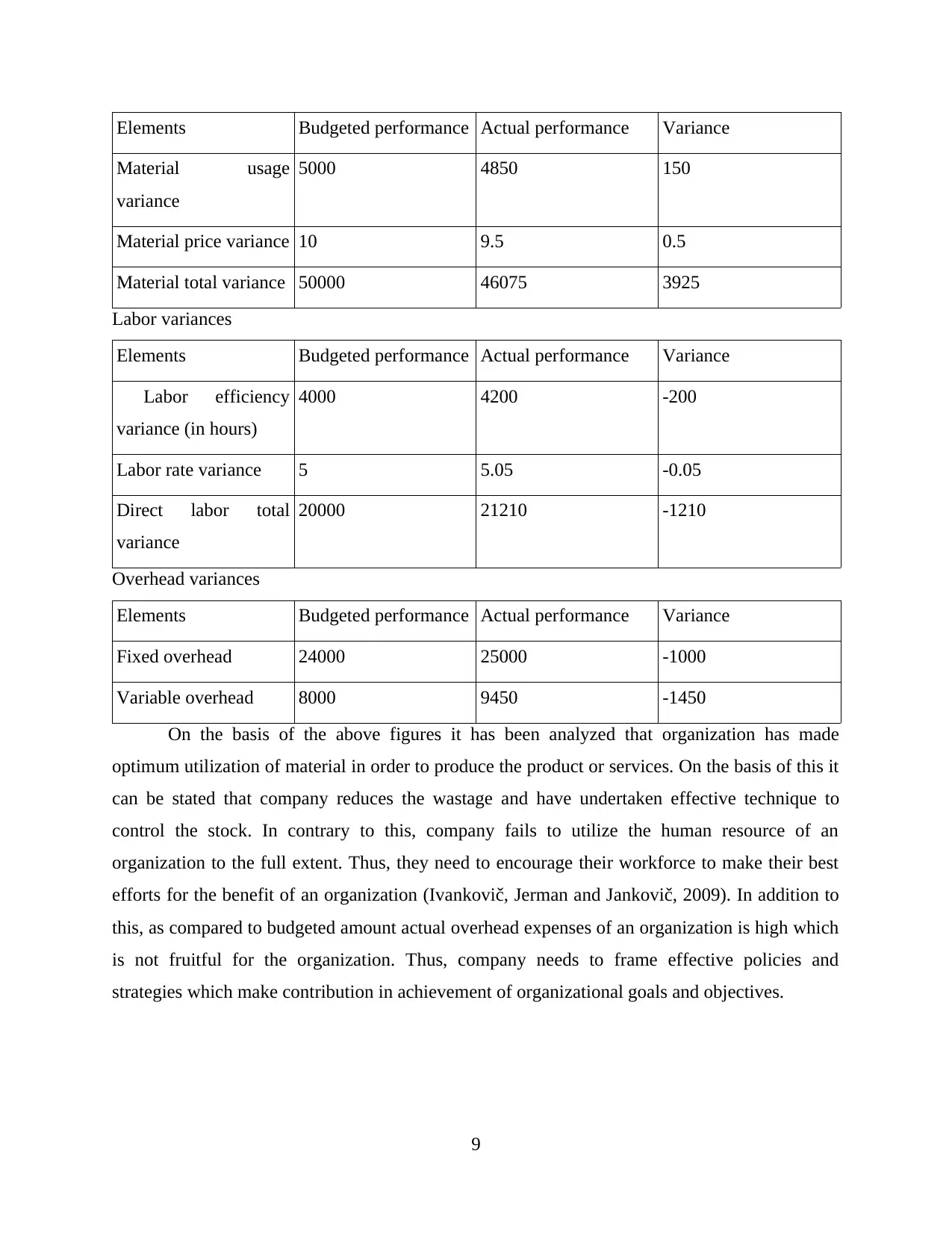
Elements Budgeted performance Actual performance Variance
Material usage
variance
5000 4850 150
Material price variance 10 9.5 0.5
Material total variance 50000 46075 3925
Labor variances
Elements Budgeted performance Actual performance Variance
Labor efficiency
variance (in hours)
4000 4200 -200
Labor rate variance 5 5.05 -0.05
Direct labor total
variance
20000 21210 -1210
Overhead variances
Elements Budgeted performance Actual performance Variance
Fixed overhead 24000 25000 -1000
Variable overhead 8000 9450 -1450
On the basis of the above figures it has been analyzed that organization has made
optimum utilization of material in order to produce the product or services. On the basis of this it
can be stated that company reduces the wastage and have undertaken effective technique to
control the stock. In contrary to this, company fails to utilize the human resource of an
organization to the full extent. Thus, they need to encourage their workforce to make their best
efforts for the benefit of an organization (Ivankovič, Jerman and Jankovič, 2009). In addition to
this, as compared to budgeted amount actual overhead expenses of an organization is high which
is not fruitful for the organization. Thus, company needs to frame effective policies and
strategies which make contribution in achievement of organizational goals and objectives.
9
Material usage
variance
5000 4850 150
Material price variance 10 9.5 0.5
Material total variance 50000 46075 3925
Labor variances
Elements Budgeted performance Actual performance Variance
Labor efficiency
variance (in hours)
4000 4200 -200
Labor rate variance 5 5.05 -0.05
Direct labor total
variance
20000 21210 -1210
Overhead variances
Elements Budgeted performance Actual performance Variance
Fixed overhead 24000 25000 -1000
Variable overhead 8000 9450 -1450
On the basis of the above figures it has been analyzed that organization has made
optimum utilization of material in order to produce the product or services. On the basis of this it
can be stated that company reduces the wastage and have undertaken effective technique to
control the stock. In contrary to this, company fails to utilize the human resource of an
organization to the full extent. Thus, they need to encourage their workforce to make their best
efforts for the benefit of an organization (Ivankovič, Jerman and Jankovič, 2009). In addition to
this, as compared to budgeted amount actual overhead expenses of an organization is high which
is not fruitful for the organization. Thus, company needs to frame effective policies and
strategies which make contribution in achievement of organizational goals and objectives.
9
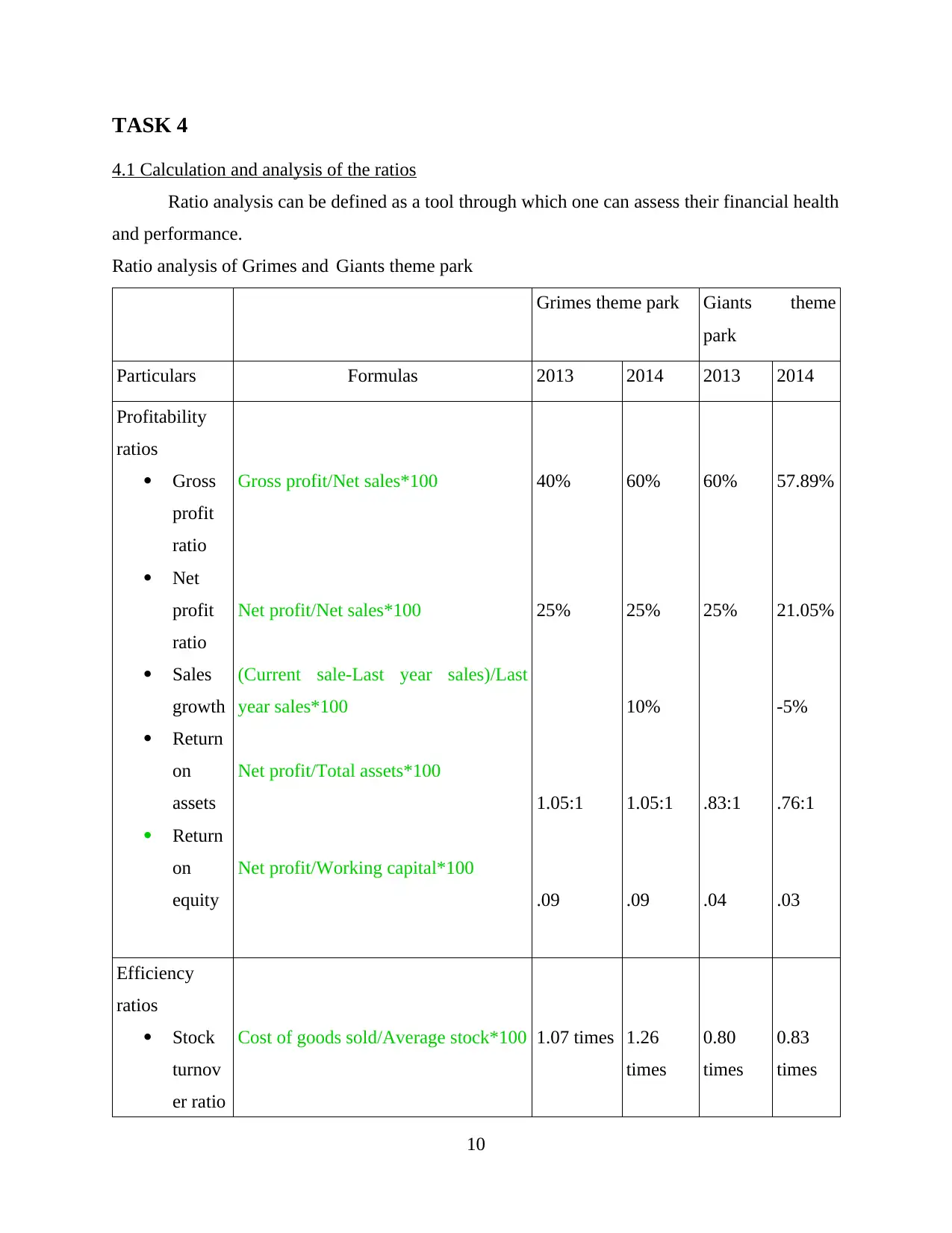
TASK 4
4.1 Calculation and analysis of the ratios
Ratio analysis can be defined as a tool through which one can assess their financial health
and performance.
Ratio analysis of Grimes and Giants theme park
Grimes theme park Giants theme
park
Particulars Formulas 2013 2014 2013 2014
Profitability
ratios
Gross
profit
ratio
Net
profit
ratio
Sales
growth
Return
on
assets
Return
on
equity
Gross profit/Net sales*100
Net profit/Net sales*100
(Current sale-Last year sales)/Last
year sales*100
Net profit/Total assets*100
Net profit/Working capital*100
40%
25%
1.05:1
.09
60%
25%
10%
1.05:1
.09
60%
25%
.83:1
.04
57.89%
21.05%
-5%
.76:1
.03
Efficiency
ratios
Stock
turnov
er ratio
Cost of goods sold/Average stock*100 1.07 times 1.26
times
0.80
times
0.83
times
10
4.1 Calculation and analysis of the ratios
Ratio analysis can be defined as a tool through which one can assess their financial health
and performance.
Ratio analysis of Grimes and Giants theme park
Grimes theme park Giants theme
park
Particulars Formulas 2013 2014 2013 2014
Profitability
ratios
Gross
profit
ratio
Net
profit
ratio
Sales
growth
Return
on
assets
Return
on
equity
Gross profit/Net sales*100
Net profit/Net sales*100
(Current sale-Last year sales)/Last
year sales*100
Net profit/Total assets*100
Net profit/Working capital*100
40%
25%
1.05:1
.09
60%
25%
10%
1.05:1
.09
60%
25%
.83:1
.04
57.89%
21.05%
-5%
.76:1
.03
Efficiency
ratios
Stock
turnov
er ratio
Cost of goods sold/Average stock*100 1.07 times 1.26
times
0.80
times
0.83
times
10
⊘ This is a preview!⊘
Do you want full access?
Subscribe today to unlock all pages.

Trusted by 1+ million students worldwide
1 out of 18
Related Documents
Your All-in-One AI-Powered Toolkit for Academic Success.
+13062052269
info@desklib.com
Available 24*7 on WhatsApp / Email
![[object Object]](/_next/static/media/star-bottom.7253800d.svg)
Unlock your academic potential
Copyright © 2020–2025 A2Z Services. All Rights Reserved. Developed and managed by ZUCOL.





